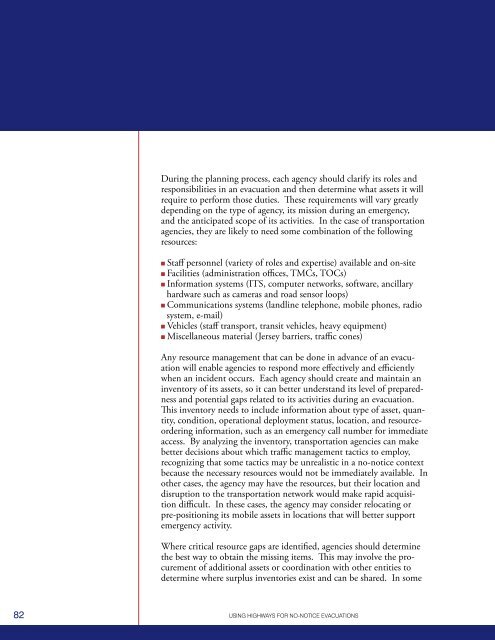using highways for no-notice evacuations - FHWA Operations - U.S. ...
using highways for no-notice evacuations - FHWA Operations - U.S. ...
using highways for no-notice evacuations - FHWA Operations - U.S. ...
Create successful ePaper yourself
Turn your PDF publications into a flip-book with our unique Google optimized e-Paper software.
During the planning process, each agency should clarify its roles andresponsibilities in an evacuation and then determine what assets it willrequire to per<strong>for</strong>m those duties. These requirements will vary greatlydepending on the type of agency, its mission during an emergency,and the anticipated scope of its activities. In the case of transportationagencies, they are likely to need some combination of the followingresources:n Staff personnel (variety of roles and expertise) available and on-siten Facilities (administration offices, TMCs, TOCs)n In<strong>for</strong>mation systems (ITS, computer networks, software, ancillaryhardware such as cameras and road sensor loops)n Communications systems (landline telephone, mobile phones, radiosystem, e-mail)n Vehicles (staff transport, transit vehicles, heavy equipment)n Miscellaneous material (Jersey barriers, traffic cones)Any resource management that can be done in advance of an evacuationwill enable agencies to respond more effectively and efficientlywhen an incident occurs. Each agency should create and maintain aninventory of its assets, so it can better understand its level of preparednessand potential gaps related to its activities during an evacuation.This inventory needs to include in<strong>for</strong>mation about type of asset, quantity,condition, operational deployment status, location, and resourceorderingin<strong>for</strong>mation, such as an emergency call number <strong>for</strong> immediateaccess. By analyzing the inventory, transportation agencies can makebetter decisions about which traffic management tactics to employ,recognizing that some tactics may be unrealistic in a <strong>no</strong>-<strong>no</strong>tice contextbecause the necessary resources would <strong>no</strong>t be immediately available. I<strong>no</strong>ther cases, the agency may have the resources, but their location anddisruption to the transportation network would make rapid acquisitiondifficult. In these cases, the agency may consider relocating orpre-positioning its mobile assets in locations that will better supportemergency activity.Where critical resource gaps are identified, agencies should determinethe best way to obtain the missing items. This may involve the procurementof additional assets or coordination with other entities todetermine where surplus inventories exist and can be shared. In some82 USING HIGHWAYS FOR NO-NOTICE EVACUATIONS
















